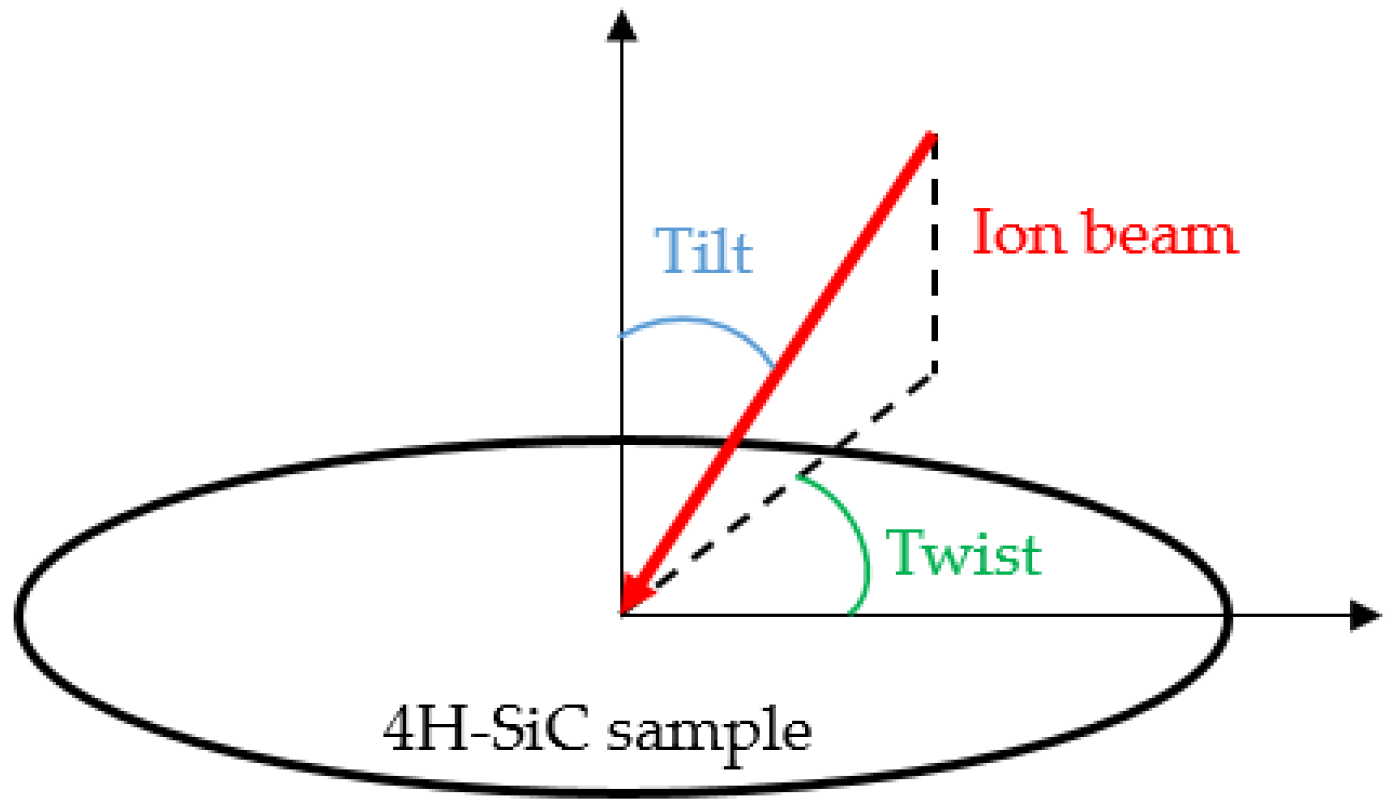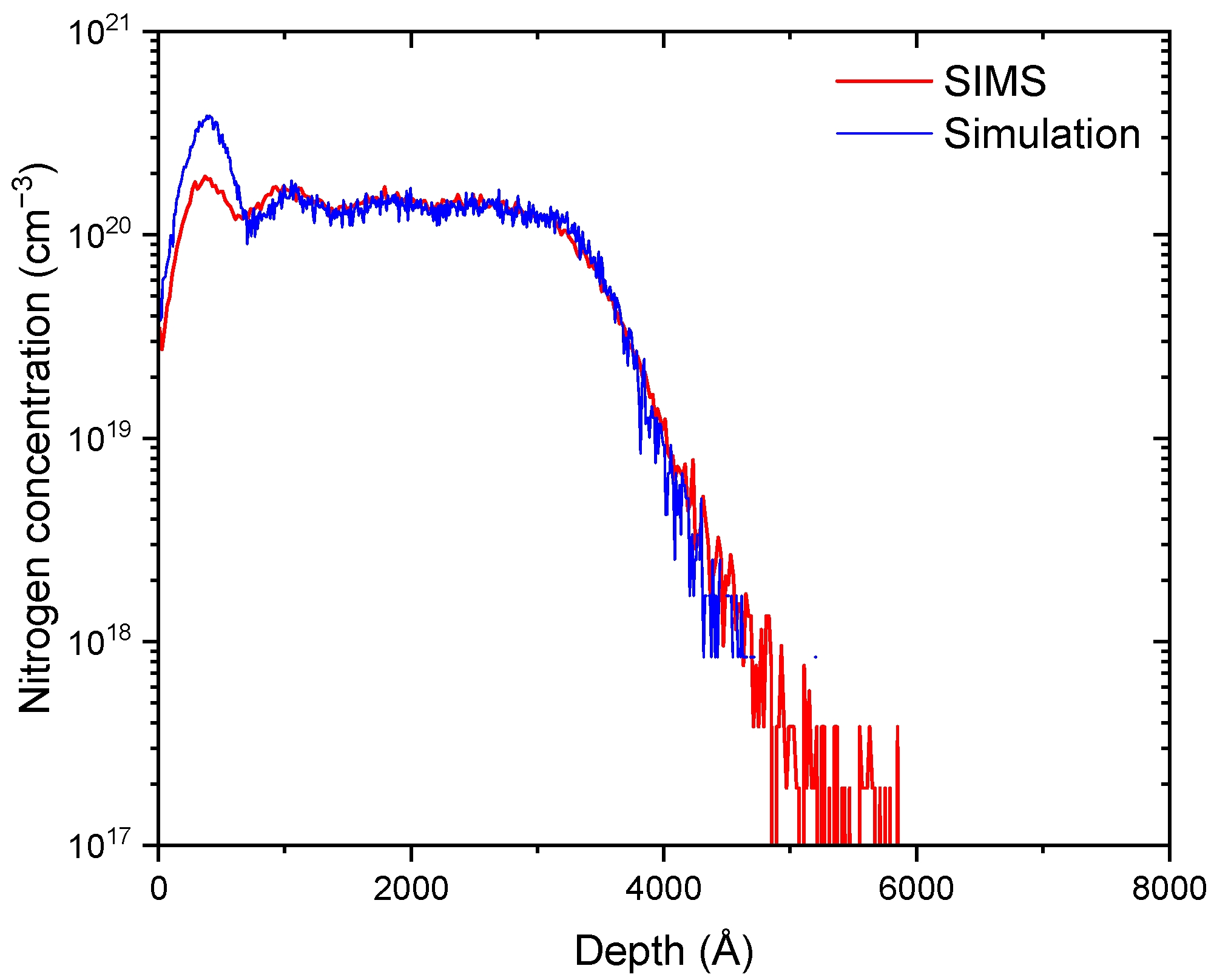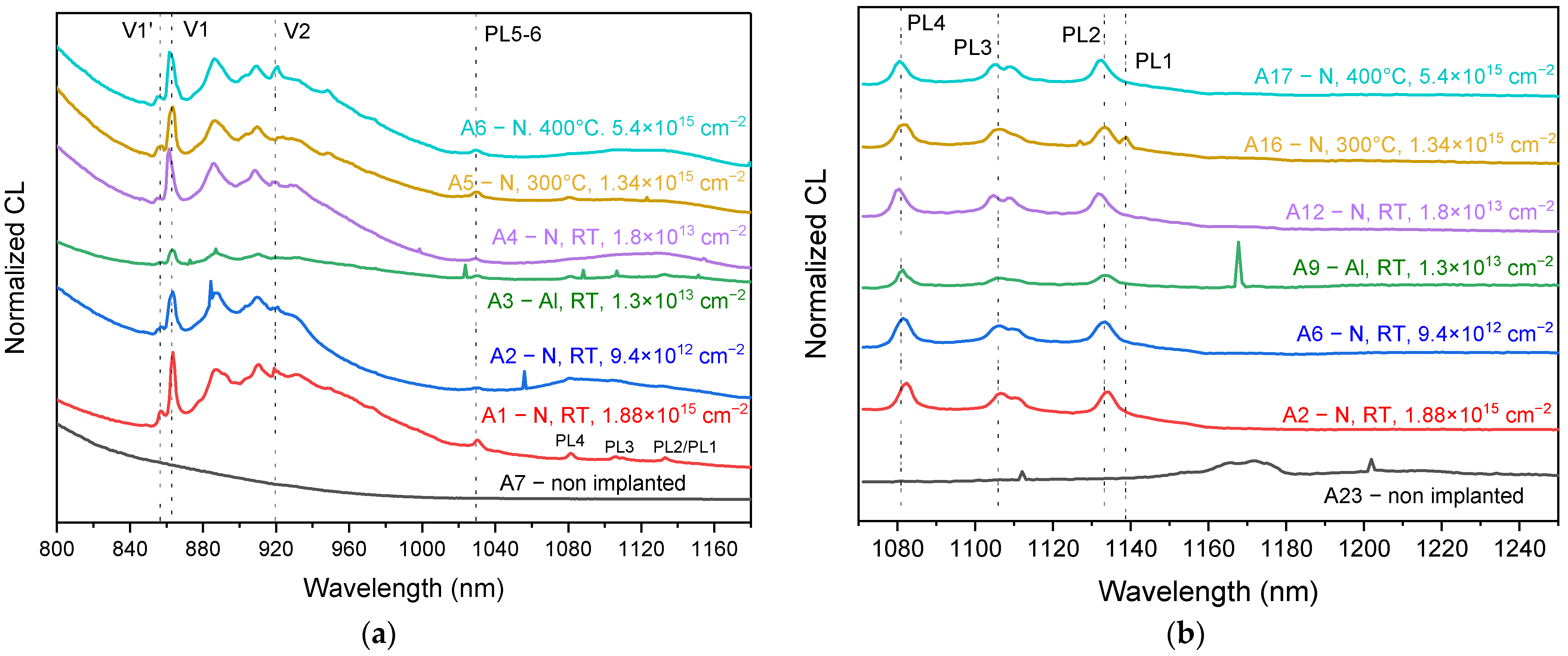Cathodoluminescence Characterization of Point Defects Generated through Ion Implantations in 4H-SiC
Abstract
:1. Introduction
2. Materials and Methods
2.1. Ion Implantation of the Samples
2.2. Dopant Concentration Estimation
2.3. Cathodoluminescence Measurements
3. Results
3.1. Dopant and Silicon Vacancy Concentration Profiles
3.2. Cathodoluminescence Results
4. Discussion
5. Conclusions
Author Contributions
Funding
Acknowledgments
Conflicts of Interest
References
- She, X.; Huang, A.Q.; Lucía, Ó.; Ozpineci, B. Review of Silicon Carbide Power Devices and Their Applications. IEEE Trans. Ind. Electron. 2017, 64, 8193–8205. [Google Scholar] [CrossRef]
- Maximilians, J. Optical Spectroscopy on Silicon Vacancy Defects in Silicon Carbide. Ph.D. Thesis, Universität Würzburg, Würzburg, Germany, 2015. [Google Scholar]
- Al Atem, A.S. Ingénierie des Centres Colorés Dans SiC Pour la Photonique et la Solotronique; Université de Lyon: Lyon, France, 2019. [Google Scholar]
- Castelletto, S.; Boretti, A. Silicon Carbide Color Centers for Quantum Applications. J. Phys. Photonics 2020, 2, 022001. [Google Scholar] [CrossRef]
- Liu, J.; Xu, Z.; Song, Y.; Wang, H.; Dong, B.; Li, S.; Ren, J.; Li, Q.; Rommel, M.; Gu, X.; et al. Confocal Photoluminescence Characterization of Silicon-Vacancy Color Centers in 4H-SiC Fabricated by a Femtosecond Laser. Nanotechnol. Precis. Eng. 2020, 3, 218–228. [Google Scholar] [CrossRef]
- Matsunami, H. Fundamental Research on Semiconductor SiC and Its Applications to Power Electronics. Proc. Jpn. Acad. Ser. B Phys. Biol. Sci. 2020, 96, 235–254. [Google Scholar] [CrossRef]
- Norman, V.A.; Majety, S.; Wang, Z.; Casey, W.H.; Curro, N.; Radulaski, M. Novel Color Center Platforms Enabling Fundamental Scientific Discovery. InfoMat 2021, 3, 869–890. [Google Scholar] [CrossRef]
- Selnesaunet, G.M. Nanostructuring of SiC for Novel Defect-Based Quantum Technologies; University of Oslo: Oslo, Norway, 2021. [Google Scholar]
- Anderson, C.P.; Glen, E.O.; Zeledon, C.; Bourassa, A.; Jin, Y.; Zhu, Y.; Vorwerk, C.; Crook, A.L.; Abe, H.; Ul-Hassan, J.; et al. Five-Second Coherence of a Single Spin with Single-Shot Readout in Silicon Carbide. Sci. Adv. 2022, 8, eabm5912. [Google Scholar] [CrossRef]
- Majety, S.; Saha, P.; Norman, V.A.; Radulaski, M. Quantum Information Processing with Integrated Silicon Carbide Photonics. J. Appl. Phys. 2022, 131, 130901. [Google Scholar] [CrossRef]
- Castelletto, S.; Maksimovic, J.; Katkus, T.; Ohshima, T.; Johnson, B.C.; Juodkazis, S. Color Centers Enabled by Direct Femto-Second Laser Writing in Wide Bandgap Semiconductors. Nanomaterials 2021, 11, 72. [Google Scholar] [CrossRef]
- Eble, B. Nitrogen Vacancy Center in Cubic Silicon Carbide: A Promising Qubit in the 1.5μm Spectral Range for Photonic Quantum Networks. Phys. Rev. B 2018, 98, 165203. [Google Scholar] [CrossRef]
- Khanaliloo, B.; Jayakumar, H.; Hryciw, A.C.; Lake, D.P.; Kaviani, H.; Barclay, P.E. Single-Crystal Diamond Nanobeam Waveguide Optomechanics. Phys. Rev. X 2015, 5, 041051. [Google Scholar] [CrossRef]
- Song, Y.; Xu, Z.; Li, R.; Wang, H.; Fan, Y.; Rommel, M.; Liu, J.; Astakhov, G.; Hlawacek, G.; Li, B.; et al. Photoluminescence and Raman Spectroscopy Study on Color Centers of Helium Ion-Implanted 4H–SiC. Nanomanuf. Metrol. 2020, 3, 205–217. [Google Scholar] [CrossRef]
- Gao, S.; Duan, Y.-Z.; Tian, Z.-N.; Zhang, Y.-L.; Chen, Q.-D.; Gao, B.-R.; Sun, H.-B. Laser-Induced Color Centers in Crystals. Opt. Laser Technol. 2022, 146, 107527. [Google Scholar] [CrossRef]
- Hallén, A.; Linnarsson, M. Ion Implantation Technology for Silicon Carbide. Surf. Coat. Technol. 2016, 306, 190–193. [Google Scholar] [CrossRef]
- Ziegler, J.F.; Ziegler, M.D.; Biersack, J.P. SRIM—The Stopping and Range of Ions in Matter (2010). Nucl. Instrum. Methods Phys. Res. Sect. B Beam Interact. Mater. At. 2010, 268, 1818–1823. [Google Scholar] [CrossRef]
- Oliviero, E.; Lazar, M.; Gardon, A.; Peaucelle, C.; Perrat, A.; Grob, J.J.; Raynaud, C.; Planson, D. High Energy N+ Ion Implantation in 4H–SiC. Nucl. Instrum. Methods Phys. Res. Sect. B Beam Interact. Mater. At. 2007, 257, 265–269. [Google Scholar] [CrossRef]
- Burcea, R.; Barbot, J.-F.; Renault, P.-O.; Eyidi, D.; Girardeau, T.; Marteau, M.; Giovannelli, F.; Zenji, A.; Rampnoux, J.-M.; Dilhaire, S.; et al. Influence of Generated Defects by Ar Implantation on the Thermoelectric Properties of ScN. ACS Appl. Energy Mater. 2022, 5, 11025–11033. [Google Scholar] [CrossRef]
- Zheng, C.; Gentils, A.; Ribis, J.; Kaïtasov, O.; Borodin, V.A.; Descoins, M.; Mangelinck, D. The Feasibility of Al-Based Oxide Precipitation in Fe–10%Cr Alloy by Ion Implantation. Philos. Mag. 2014, 94, 2937–2955. [Google Scholar] [CrossRef]
- Silicon Carbide Power & GaN RF Solutions|Wolfspeed. Available online: https://www.wolfspeed.com/ (accessed on 27 April 2023).
- Morvan, E. Modélisation de l’implantation Ionique Dans α-SiC et Application à La Conception de Composants de Puissance. Ph.D. Thesis, Institut National des Sciences Appliquées de Lyon, Lyon, France, 1999. [Google Scholar]
- Morvan, E.; Mestres, N.; Campos, F.J.; Pascual, J.; Hallén, A.; Linnarsson, M.K.; Kuznetsov, A.Y. Damage Reduction in Channeled Ion Implanted 6H-SiC. Mater. Sci. Forum 2000, 338–342, 893–896. [Google Scholar] [CrossRef]
- Shimizu, R.; Ze-Jun, D. Monte Carlo Modelling of Electron-Solid Interactions. Rep. Prog. Phys. 1992, 55, 487. [Google Scholar] [CrossRef]
- Yunogami, T.; Mizutani, T. Radiation Damage in SiO2/Si Induced by Low-energy Electrons via Plasmon Excitation. J. Appl. Phys. 1993, 73, 8184–8188. [Google Scholar] [CrossRef]
- Everhart, T.E.; Hoff, P.H. Determination of Kilovolt Electron Energy Dissipation vs Penetration Distance in Solid Materials. J. Appl. Phys. 2003, 42, 5837–5846. [Google Scholar] [CrossRef]
- Werner, U.; Koch, F.; Oelgart, G. Kilovolt Electron Energy Loss Distribution in Si. J. Phys. Appl. Phys. 1988, 21, 116–124. [Google Scholar] [CrossRef]
- Wang, J.-F.; Yan, F.-F.; Li, Q.; Liu, Z.-H.; Liu, H.; Guo, G.-P.; Guo, L.-P.; Zhou, X.; Cui, J.-M.; Wang, J.; et al. Coherent Control of Nitrogen-Vacancy Center Spins in Silicon Carbide at Room Temperature. Phys. Rev. Lett. 2020, 124, 223601. [Google Scholar] [CrossRef] [PubMed]
- Bracher, D.O.; Hu, E.L. Fabrication of High- Q Nanobeam Photonic Crystals in Epitaxially Grown 4H-SiC. Nano Lett. 2015, 15, 6202–6207. [Google Scholar] [CrossRef] [PubMed]
- Koehl, W.F.; Buckley, B.B.; Heremans, F.J.; Calusine, G.; Awschalom, D.D. Room Temperature Coherent Control of Defect Spin Qubits in Silicon Carbide. Nature 2011, 479, 84–87. [Google Scholar] [CrossRef]
- Ivády, V.; Davidsson, J.; Son, N.T.; Ohshima, T.; Abrikosov, I.A.; Gali, A. Identification of Si-Vacancy Related Room-Temperature Qubits in $4H$ Silicon Carbide. Phys. Rev. B 2017, 96, 161114. [Google Scholar] [CrossRef]
- Ivády, V.; Davidsson, J.; Delegan, N.; Falk, A.L.; Klimov, P.V.; Whiteley, S.J.; Hruszkewycz, S.O.; Holt, M.V.; Heremans, F.J.; Son, N.T.; et al. Stabilization of Point-Defect Spin Qubits by Quantum Wells. Nat. Commun. 2019, 10, 5607. [Google Scholar] [CrossRef]
- Bracher, D.O.; Zhang, X.; Hu, E.L. Selective Purcell Enhancement of Two Closely Linked Zero-Phonon Transitions of a Silicon Carbide Color Center. Proc. Natl. Acad. Sci. USA 2017, 114, 4060–4065. [Google Scholar] [CrossRef]
- Nagy, R.; Niethammer, M.; Widmann, M.; Chen, Y.-C.; Udvarhelyi, P.; Bonato, C.; Hassan, J.U.; Karhu, R.; Ivanov, I.G.; Son, N.T.; et al. High-Fidelity Spin and Optical Control of Single Silicon-Vacancy Centres in Silicon Carbide. Nat. Commun. 2019, 10, 1954. [Google Scholar] [CrossRef]
- Wagner, M.; Magnusson, B.; Chen, W.M.; Janzén, E.; Sörman, E.; Hallin, C.; Lindström, J.L. Electronic Structure of the Neutral Silicon Vacancy in 4H and 6H SiC. Phys. Rev. B 2000, 62, 16555–16560. [Google Scholar] [CrossRef]
- Favennec, P.-N. l’Implantation Ionique. Pour la Microélectronique et l’Optique; Masson, E., Ed.; CNET-ENST: Paris, France, 1993. [Google Scholar]
- Mattausch, A.; Bockstedte, M.; Pankratov, O. Ab-Initio Study of Dopant Interstitials in 4H-SiC. Mater. Sci. Forum 2005, 483–485, 523–526. [Google Scholar] [CrossRef]
- Pernot, J.; Contreras, S.; Camassel, J. Electrical Transport Properties of Aluminum-Implanted 4H–SiC. J. Appl. Phys. 2005, 98, 023706. [Google Scholar] [CrossRef]
- Lazar, M.; Raynaud, C.; Planson, D.; Chante, J.-P.; Locatelli, M.-L.; Ottaviani, L.; Godignon, P. Effect of Ion Implantation Parameters on Al Dopant Redistribution in SiC after Annealing: Defect Recovery and Electrical Properties of p-Type Layers. J. Appl. Phys. 2003, 94, 2992–2998. [Google Scholar] [CrossRef]
- Zargaleh, S.A.; Eble, B.; Hameau, S.; Cantin, J.-L.; Legrand, L.; Bernard, M.; Margaillan, F.; Lauret, J.-S.; Roch, J.-F.; von Bardeleben, H.J.; et al. Evidence for Near-Infrared Photoluminescence of Nitrogen Vacancy Centers in 4H-SiC. Phys. Rev. B 2016, 94, 060102. [Google Scholar] [CrossRef]
- Kakanakova-Georgieva, A.; Yakimova, R.; Henry, A.; Linnarsson, M.K.; Syväjärvi, M.; Janzén, E. Cathodoluminescence Identification of Donor–Acceptor Related Emissions in as-Grown 4H–SiC Layers. J. Appl. Phys. 2002, 91, 2890–2895. [Google Scholar] [CrossRef]
- Ottaviani, L.; Hidalgo, P.; Idrissi, H.; Lancin, M.; Martinuzzi, S.; Pichaud, B. Structural Characterization of 6H- and 4H-SiC Polytypes by Means of Cathodoluminescence and X-ray Topography. J. Phys. Condens. Matter 2003, 16, S107. [Google Scholar] [CrossRef]
- Son, N.T.; Shafizadeh, D.; Ohshima, T.; Ivanov, I.G. Modified Divacancies in 4H-SiC. J. Appl. Phys. 2022, 132, 025703. [Google Scholar] [CrossRef]







| Name | Dopant | Temperature [°C] | Energy [keV] | Dose [cm−2] |
|---|---|---|---|---|
| A2 | N15 | RT | 400 | 6.4 1014 |
| 270 | 4.6 1014 | |||
| 170 | 4 1014 | |||
| 100 | 3.8 1014 | |||
| Total: 1.88 1015 | ||||
| A6 | N | RT | 400 | 3.2 1012 |
| 270 | 2.3 1012 | |||
| 170 | 2 1012 | |||
| 100 | 1.9 1012 | |||
| Total: 9.4 1012 | ||||
| A9 | Al | RT | 300 | 5.93 1012 |
| 190 | 2.9 1012 | |||
| 115 | 2.08 1012 | |||
| 60 | 1.42 1012 | |||
| 25 | 6.81 1011 | |||
| Total: 1.3 1013 | ||||
| A12 | N | RT | 190 | 5.6 1012 |
| 135 | 3.6 1012 | |||
| 90 | 3.4 1012 | |||
| 50 | 3.2 1012 | |||
| 30 | 2.2 1012 | |||
| Total: 1.8 1013 | ||||
| A16 | N | 300 | 160 | 5 1014 |
| 110 | 2.8 1014 | |||
| 70 | 2.5 1014 | |||
| 40 | 1.8 1014 | |||
| 20 | 1.3 1014 | |||
| Total: 1.34 1015 | ||||
| A17 | N | 400 | 190 | 1.5 1015 |
| 135 | 9 1014 | |||
| 90 | 9 1014 | |||
| 50 | 8 1014 | |||
| 20 | 1.3 1015 | |||
| Total: 5.4 1015 | ||||
| A23 | NA | NA | NA | NA |
| Defects | Configuration | Designation | ZPLs (nm) Theory [3,4,31,32] | ZPLs (nm) Experimental |
|---|---|---|---|---|
| VSi | h | V1, V1′ | 862, 858 | 862, 856 |
| k | V2 | 917 | 912–919 | |
| VCVSi | hh | PL1 | 1132 | 1139 |
| kk | PL2 | 1131 | 1133 | |
| kh | PL3 | 1108 | 1110 | |
| hk | PL4 | 1078 | 1080 | |
| VCVSi near a stacking fault (ssf) | k1h1-ssf | PL5 | 1042 | 1030 |
| k2k2-ssf | PL6 | 1038 | ||
| k2k1-ssf | PL7 | unknown |
Disclaimer/Publisher’s Note: The statements, opinions and data contained in all publications are solely those of the individual author(s) and contributor(s) and not of MDPI and/or the editor(s). MDPI and/or the editor(s) disclaim responsibility for any injury to people or property resulting from any ideas, methods, instructions or products referred to in the content. |
© 2023 by the authors. Licensee MDPI, Basel, Switzerland. This article is an open access article distributed under the terms and conditions of the Creative Commons Attribution (CC BY) license (https://creativecommons.org/licenses/by/4.0/).
Share and Cite
Vuillermet, E.; Bercu, N.; Etienne, F.; Lazar, M. Cathodoluminescence Characterization of Point Defects Generated through Ion Implantations in 4H-SiC. Coatings 2023, 13, 992. https://doi.org/10.3390/coatings13060992
Vuillermet E, Bercu N, Etienne F, Lazar M. Cathodoluminescence Characterization of Point Defects Generated through Ion Implantations in 4H-SiC. Coatings. 2023; 13(6):992. https://doi.org/10.3390/coatings13060992
Chicago/Turabian StyleVuillermet, Enora, Nicolas Bercu, Florence Etienne, and Mihai Lazar. 2023. "Cathodoluminescence Characterization of Point Defects Generated through Ion Implantations in 4H-SiC" Coatings 13, no. 6: 992. https://doi.org/10.3390/coatings13060992
APA StyleVuillermet, E., Bercu, N., Etienne, F., & Lazar, M. (2023). Cathodoluminescence Characterization of Point Defects Generated through Ion Implantations in 4H-SiC. Coatings, 13(6), 992. https://doi.org/10.3390/coatings13060992






